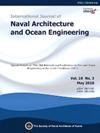基于噪声源识别方法的矩形截面壳体声辐射机理研究
IF 3.9
3区 工程技术
Q2 ENGINEERING, MARINE
International Journal of Naval Architecture and Ocean Engineering
Pub Date : 2025-01-01
DOI:10.1016/j.ijnaoe.2025.100650
引用次数: 0
摘要
为了揭示矩形截面壳体的声辐射机理,提出了一种不规则壳体的噪声源识别方法。该方法采用结构-有限元与流体-边界元耦合的方法对流固耦合振动进行解耦,得到了壳体的振动和压力。随后,以这些结果为输入,通过求解非均匀离散模型的声辐射模态分解问题,实现了壳体噪声源识别。具体而言,通过设计流固耦合振动解耦方法,使得后续声辐射模态分解可以利用相同的声辐射阻抗矩阵,从而提高计算效率。利用该方法分析了矩形截面壳体的主要声辐射形式及其相关规律,揭示了壳体的一般声辐射机理。这为矩形截面壳体的精确降噪提供了必要的理论和技术支持。本文章由计算机程序翻译,如有差异,请以英文原文为准。
Research on sound radiation mechanism of rectangular cross-section shell based on noise source identification method
To reveal the acoustic radiation mechanism of rectangular cross-section shells, a noise source identification method for irregular shells is proposed. This method decouples the fluid-structure interaction vibration by using the method of structural-finite-element coupled with fluid-boundary-element, and obtains the vibration and pressure of the shell. Subsequently, using these results as input, the noise source identification of the shell is accomplished by solving the acoustic radiation mode decomposition problem of non-uniform discrete models. Specifically, by designing a decoupling approach for the fluid-structure interaction vibration, the subsequent acoustic radiation mode decompositions can utilize the same acoustic radiation impedance matrix, thereby enhancing the computational efficiency. Utilizing this method, the main acoustic radiation forms rectangular cross-section shell and their related laws were analyzed, and the general acoustic radiation mechanism of the shell was revealed. This provides essential theoretical and technical support for the precise noise reduction of the rectangular cross-section shell.
求助全文
通过发布文献求助,成功后即可免费获取论文全文。
去求助
来源期刊

International Journal of Naval Architecture and Ocean Engineering
ENGINEERING, MARINE-
CiteScore
4.90
自引率
4.50%
发文量
62
审稿时长
12 months
期刊介绍:
International Journal of Naval Architecture and Ocean Engineering provides a forum for engineers and scientists from a wide range of disciplines to present and discuss various phenomena in the utilization and preservation of ocean environment. Without being limited by the traditional categorization, it is encouraged to present advanced technology development and scientific research, as long as they are aimed for more and better human engagement with ocean environment. Topics include, but not limited to: marine hydrodynamics; structural mechanics; marine propulsion system; design methodology & practice; production technology; system dynamics & control; marine equipment technology; materials science; underwater acoustics; ocean remote sensing; and information technology related to ship and marine systems; ocean energy systems; marine environmental engineering; maritime safety engineering; polar & arctic engineering; coastal & port engineering; subsea engineering; and specialized watercraft engineering.
 求助内容:
求助内容: 应助结果提醒方式:
应助结果提醒方式:


